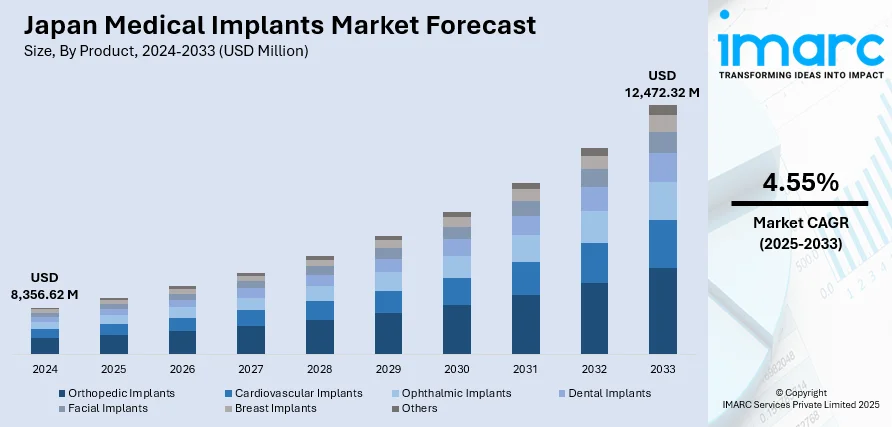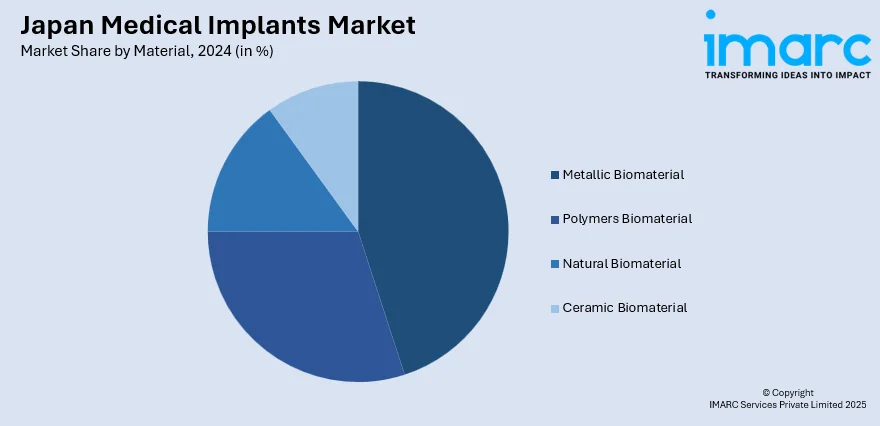
Japan Medical Implants Market Size, Share, Trends and Forecast by Product, Material, and Region, 2025-2033
Japan Medical Implants Market Overview:
The Japan medical implants market size reached USD 8,356.62 Million in 2024. Looking forward, IMARC Group expects the market to reach USD 12,472.32 Million by 2033, exhibiting a growth rate (CAGR) of 4.55% during 2025-2033. The market is advancing steadily, propelled by an aging population and increasing prevalence of chronic conditions such as cardiovascular and orthopedic disorders. Innovations like 3D printing and advanced biomaterials are also enhancing implant customization and patient outcomes. The adoption of minimally invasive surgical techniques is further contributing to the expansion of the Japan medical implants market share.
|
Report Attribute
|
Key Statistics
|
|---|---|
|
Base Year
|
2024
|
|
Forecast Years
|
2025-2033
|
|
Historical Years
|
2019-2024
|
| Market Size in 2024 | USD 8,356.62 Million |
| Market Forecast in 2033 | USD 12,472.32 Million |
| Market Growth Rate 2025-2033 | 4.55% |
Japan Medical Implants Market Trends:
Aging Population and Rising Chronic Diseases
One of the oldest populations in the world is found in Japan, with a significant portion aged 65 and above. Due to the shift in demographics, osteoarthritis, cardiovascular disease and conditions affecting bones are more common among seniors. This has led to more people seeking treatments using hip and knee replacements, pacemakers and dental implants. The rise in older people leads to more implant surgeries and also requires products that resist wear, provide long life, and are safe in the body. Moreover, problems like diabetes and obesity lead to complications that are often solved with surgeries using implants. As Japan continues to face rising life expectancy and healthcare needs, the demand for reliable and effective medical implant solutions plays a central role in driving market expansion.

To get more information on this market, Request Sample
Advancements in Implant Technology
Technological innovation is a key driver of growth in Japan’s medical implants market. The integration of 3D printing, robotic-assisted surgery, and smart implant technology is transforming patient care. These advancements allow for more personalized implants that match the patient’s anatomy, improving surgical outcomes and recovery times. Additionally, the development of new biomaterials enhances implant durability, biocompatibility, and resistance to infection. Japan’s strong R&D infrastructure and collaboration between medical institutions, universities, and tech companies foster rapid innovation. Regulatory support for approving new devices efficiently also accelerates the adoption of cutting-edge technologies. These improvements enhance patient satisfaction and also make procedures less invasive and more cost-effective in the long term, making innovation a core pillar of Japan medical implants market growth.
Government Support and Healthcare Infrastructure
Japan's government plays a crucial role in supporting the medical implants market through favorable regulations, healthcare subsidies, and innovation funding. The country has a universal healthcare system that provides broad access to surgical and rehabilitation services, enabling more patients to afford implant procedures. Agencies such as the Pharmaceuticals and Medical Devices Agency (PMDA) ensure safety while streamlining approval processes for new implants. Additionally, government-funded programs promote technological research and partnerships between academia and industry. Infrastructure developments, including modern hospitals and specialized surgical centers, ensure that advanced implant procedures are widely available across the country. These efforts not only improve patient access and outcomes but also create a stable environment for international and local companies to invest and grow within Japan’s medical implants ecosystem.
Japan Medical Implants Market Segmentation:
IMARC Group provides an analysis of the key trends in each segment of the market, along with forecasts at the country and regional levels for 2025-2033. Our report has categorized the market based on product and material.
Product Insights:
- Orthopedic Implants
- Hip Orthopedic Device
- Joint Reconstruction
- Knee Orthopedic Devices
- Spine Orthopedic Devices
- Others
- Cardiovascular Implants
- Pacing devices
- Stents
- Structural Cardiac Implants
- Ophthalmic Implants
- Intraocular lens
- Glaucoma Implants
- Dental Implants
- Facial Implants
- Breast Implants
- Others
The report has provided a detailed breakup and analysis of the market based on the product. This includes orthopedic implants (hip orthopedic device, joint reconstruction, knee orthopedic devices, spine orthopedic devices, and others), cardiovascular implants (pacing devices, stents, and structural cardiac implants), ophthalmic implants (intraocular lens and glaucoma implants), dental implants, facial implants, breast implants, and others.
Material Insights:

- Metallic Biomaterial
- Polymers Biomaterial
- Natural Biomaterial
- Ceramic Biomaterial
A detailed breakup and analysis of the market based on the material have also been provided in the report. This includes metallic biomaterial, polymers biomaterial, natural biomaterial, and ceramic biomaterial.
Regional Insights:
- Kanto Region
- Kansai/Kinki Region
- Central/ Chubu Region
- Kyushu-Okinawa Region
- Tohoku Region
- Chugoku Region
- Hokkaido Region
- Shikoku Region
The report has also provided a comprehensive analysis of all the major regional markets, which include the Kanto Region, Kansai/Kinki Region, Central/ Chubu Region, Kyushu-Okinawa Region, Tohoku Region, Chugoku Region, Hokkaido Region, and Shikoku Region.
Competitive Landscape:
The market research report has also provided a comprehensive analysis of the competitive landscape. Competitive analysis such as market structure, key player positioning, top winning strategies, competitive dashboard, and company evaluation quadrant has been covered in the report. Also, detailed profiles of all major companies have been provided.
Japan Medical Implants Market News:
- In February 2024, the TSX Implant was introduced in Japan by ZimVie Inc., a leading life sciences company in the dentistry and spine sectors worldwide. Japan is a key strategic market for ZimVie, being the company's largest dental implant market in Asia and its sixth largest worldwide. With TSX's introduction in Japan, the business may now directly compete with high-end market leaders in the dental implant industry.
Japan Medical Implants Market Report Coverage:
| Report Features | Details |
|---|---|
| Base Year of the Analysis | 2024 |
| Historical Period | 2019-2024 |
| Forecast Period | 2025-2033 |
| Units | Million USD |
| Scope of the Report |
Exploration of Historical Trends and Market Outlook, Industry Catalysts and Challenges, Segment-Wise Historical and Future Market Assessment:
|
| Products Covered |
|
| Materials Covered | Metallic Biomaterial, Polymers Biomaterial, Natural Biomaterial, Ceramic Biomaterial |
| Regions Covered | Kanto Region, Kansai/Kinki Region, Central/ Chubu Region, Kyushu-Okinawa Region, Tohoku Region, Chugoku Region, Hokkaido Region, Shikoku Region |
| Customization Scope | 10% Free Customization |
| Post-Sale Analyst Support | 10-12 Weeks |
| Delivery Format | PDF and Excel through Email (We can also provide the editable version of the report in PPT/Word format on special request) |
Key Questions Answered in This Report:
- How has the Japan medical implants market performed so far and how will it perform in the coming years?
- What is the breakup of the Japan medical implants market on the basis of product?
- What is the breakup of the Japan medical implants market on the basis of material?
- What is the breakup of the Japan medical implants market on the basis of region?
- What are the various stages in the value chain of the Japan medical implants market?
- What are the key driving factors and challenges in the Japan medical implants market?
- What is the structure of the Japan medical implants market and who are the key players?
- What is the degree of competition in the Japan medical implants market?
Key Benefits for Stakeholders:
- IMARC’s industry report offers a comprehensive quantitative analysis of various market segments, historical and current market trends, market forecasts, and dynamics of the Japan medical implants market from 2019-2033.
- The research report provides the latest information on the market drivers, challenges, and opportunities in the Japan medical implants market.
- Porter's five forces analysis assist stakeholders in assessing the impact of new entrants, competitive rivalry, supplier power, buyer power, and the threat of substitution. It helps stakeholders to analyze the level of competition within the Japan medical implants industry and its attractiveness.
- Competitive landscape allows stakeholders to understand their competitive environment and provides an insight into the current positions of key players in the market.
Need more help?
- Speak to our experienced analysts for insights on the current market scenarios.
- Include additional segments and countries to customize the report as per your requirement.
- Gain an unparalleled competitive advantage in your domain by understanding how to utilize the report and positively impacting your operations and revenue.
- For further assistance, please connect with our analysts.
 Request Customization
Request Customization
 Speak to an Analyst
Speak to an Analyst
 Request Brochure
Request Brochure
 Inquire Before Buying
Inquire Before Buying




.webp)




.webp)












